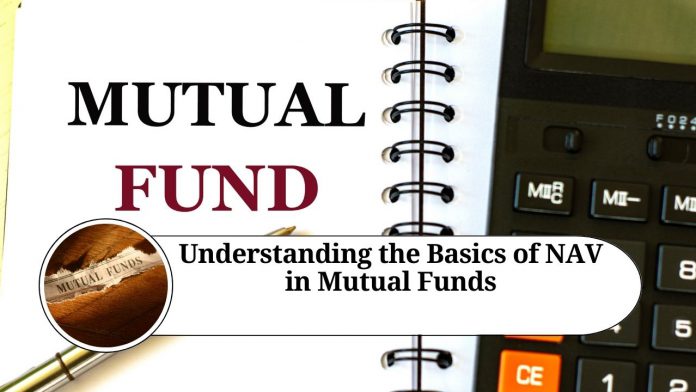Investing in mutual funds has become a popular choice among investors seeking to grow their wealth. Mutual funds offer a convenient way to diversify your investment portfolio and access professional management of your investments. When you invest in mutual funds, one of the most important terms to understand is Net Asset Value (NAV). In this blog, we will discuss the basics of NAV in mutual funds.
What is Net Asset Value (NAV)?
NAV is the value of each unit of a mutual fund scheme. It is calculated by dividing the total value of the fund’s assets by the total number of units outstanding. In simple terms, it is the market value of all the securities held by the fund, including cash and cash equivalents, minus any liabilities, divided by the number of units outstanding.
How is NAV calculated?
NAV is calculated on a daily basis after the market closes. The mutual fund house takes the market value of all the securities held by the fund and deducts any liabilities such as expenses and fees. The resulting figure is then divided by the total number of units outstanding in the fund.
For example, if a mutual fund has assets worth Rs. 100 crore and liabilities worth Rs. 1 crore, and has issued 10 crore units, then the NAV of the mutual fund would be:
NAV = (100 – 1) crore / 10 crore = Rs. 9 per unit
Why is NAV important?
NAV is an important metric as it provides investors with the current value of their investment in a mutual fund. Investors can use the NAV to calculate the value of their holdings in the mutual fund, which is particularly useful when they want to buy or sell units.
The NAV of a mutual fund also determines the price at which units are issued or redeemed. For example, if an investor wants to invest Rs. 10,000 in a mutual fund with an NAV of Rs. 10, they will receive 1,000 units. Similarly, if an investor wants to redeem 1,000 units of a mutual fund with an NAV of Rs. 11, they will receive Rs. 11,000.
It is important to note that the NAV of a mutual fund does not reflect the returns generated by the mutual fund. The returns of a mutual fund are calculated based on the change in NAV over a specific period, usually expressed as a percentage.
Factors that affect NAV
The NAV of a mutual fund can be influenced by various factors such as changes in the market value of securities held by the fund, expenses, and fees charged by the fund house, and inflows and outflows of money from the fund.
Market fluctuations can cause the value of the securities held by the fund to rise or fall, which can affect the NAV of the mutual fund. Higher expenses and fees charged by the fund house can also reduce the NAV of the mutual fund. Inflows and outflows of money from the fund can also impact the NAV. When more money flows into the fund, the NAV increases, and when more money is redeemed from the fund, the NAV decreases.
Conclusion
NAV is an important metric that investors should understand when investing in mutual funds. It provides investors with the current value of their investment in a mutual fund and is used to calculate the price at which units are issued or redeemed. It is important to note that NAV does not reflect the returns generated by the mutual fund, and various factors such as market fluctuations, expenses, and inflows and outflows of money can affect the NAV of the mutual fund. As always, investors should consult with a financial advisor to determine if mutual funds are appropriate for their investment objectives and risk tolerance.
Read more useful content:
- How to invest in mutual funds
- Best Technology Mutual Funds
- All about mutual funds-types & importance
- The Power of SIP Investment in Mutual Funds
Frequently Asked Questions (FAQs)
Q: What is NAV in mutual funds?
A: NAV stands for Net Asset Value, which is the per-unit market value of a mutual fund scheme. It is calculated by dividing the total value of the fund’s assets by the total number of units outstanding.
Q: How is NAV calculated in mutual funds?
A: NAV is calculated by subtracting the total liabilities of the fund from its total assets, and then dividing the resulting figure by the number of units outstanding.
Q: How often is NAV calculated in mutual funds?
A: NAV is calculated on a daily basis for mutual fund schemes.
Q: How is NAV used in mutual funds?
A: NAV is used to determine the value of an investor’s holdings in a mutual fund. It also determines the price at which units are issued or redeemed.
Q: Can the NAV of a mutual fund decrease?
A: Yes, the NAV of a mutual fund can decrease due to a variety of factors, such as market fluctuations, higher expenses and fees, and outflows of money from the fund.
Q: Can the NAV of a mutual fund increase?
A: Yes, the NAV of a mutual fund can increase due to factors such as market gains, inflows of money into the fund, and effective management of the fund’s investments.
Q: What is the significance of NAV in mutual funds?
A: NAV is an important metric that provides investors with the current value of their investment in a mutual fund. It is used to calculate the price at which units are issued or redeemed, and can also impact the returns generated by the mutual fund.
Q: Should I invest in a mutual fund based solely on its NAV?
A: No, investors should not base their investment decisions solely on the NAV of a mutual fund. Other important factors such as the fund’s investment objective, past performance, and fees should also be considered.




















